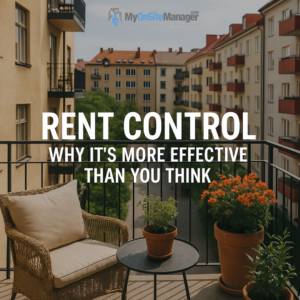For decades, rent control has been framed as a villain in housing policy debates. Economists, landlords, and policymakers often argue that controlling rent prices leads to reduced housing supply, poor maintenance, and an overall decline in housing quality. But as Cahal Moran argues in his article for Current Affairs, these critiques rely on outdated or oversimplified economic models that don’t reflect how modern rent control policies actually work.
Rent control today isn’t about freezing rent indefinitely or punishing landlords it’s about balancing the power between renters and the market, ensuring that people aren’t priced out of their homes while still allowing for healthy housing development.
(Read the original article here)
The Myth of “Bad Economics”
The conventional narrative is clear: when you put a cap on prices, supply will shrink. Critics point to historical examples from the mid-20th century, when “first-generation” rent control policies imposed rigid rent freezes, discouraging landlords from maintaining or building new housing.
However, this argument ignores two key points:
-
Modern rent control isn’t the same as those old systems.
-
The housing crisis today isn’t just about supply it’s also about affordability and stability.
Moran’s argument is that modern rent control policies often called “second-generation” rent control are far more flexible and designed to stabilize rent increases, not eliminate them. For example, a common model allows annual increases tied to inflation or a fixed percentage (e.g., 3-5% per year). These systems protect tenants from sudden rent spikes while still enabling landlords to cover costs and make profits.
What Modern Rent Control Really Does
1. Protects Tenants from Unpredictable Spikes
Imagine a family renting an apartment for $1,200/month. Without rent control, the landlord could raise rent by $300 or $400 annually, forcing the family to relocate. Rent control stabilizes these increases, allowing small, predictable adjustments that help families budget for the long term.
2. Reduces Displacement
In cities like New York, Los Angeles, and San Francisco, rent control has been shown to prevent mass displacement, particularly for vulnerable groups like seniors or low-income families. Stability allows tenants to stay in their neighborhoods, preserving community ties and local culture.
3. Encourages Long-Term Tenancies
Tenants with stable rent are more likely to stay longer, which reduces vacancy rates and turnover costs for landlords. A stable tenant-landlord relationship benefits both parties.
Debunking the “Supply Killer” Argument
Critics argue that rent control discourages new housing development. While this was true of older systems, modern policies typically exempt new construction for a set number of years often 10-20 years to encourage investment.
Research has shown that in cities with modern rent regulations:
-
Construction continues, particularly when paired with tax incentives and zoning reforms.
-
Developers adjust to predictable rent rules, focusing on long-term profitability rather than short-term gains.
Moran also highlights that most rental price volatility isn’t caused by rent control but by the lack of affordable housing policies overall.
Why Supply Alone Isn’t the Answer
“Just build more housing” is the common rallying cry to fix the housing crisis. While increasing supply is important, new construction often focuses on luxury apartments units that are far out of reach for middle- or low-income renters. Without rent control, even existing affordable units become subject to extreme rent hikes.
Rent control serves as a bridge policy: it doesn’t solve all problems but buys time for renters while governments work on longer-term solutions like affordable housing developments and zoning reforms.
Real-World Examples of Rent Control Success
-
Berlin, Germany: While Berlin’s 2020 rent cap faced legal challenges, the initial results showed significant rent stabilization, with tenant displacement decreasing in high-demand areas.
-
Oregon, USA: In 2019, Oregon introduced statewide rent control with an annual increase cap of 7% plus inflation. This policy balanced tenant protection while avoiding major disruptions to new construction.
-
California, USA: Cities like San Francisco, with rent stabilization, have seen stronger tenant retention rates, preventing waves of evictions during economic downturns.
The Social Case for Rent Control
Rent control isn’t just about economics it’s about human stability. When renters are constantly worried about rising costs, they’re less able to invest in their communities, plan for their futures, or even save for homeownership.
Stable rents mean:
-
Lower rates of homelessness and eviction.
-
Stronger neighborhood ties.
-
More equitable access to urban centers, preventing cities from becoming enclaves for the wealthy.
Policy Recommendations for Effective Rent Control
To ensure that rent control works as intended, Moran suggests a combination of smart design and complementary policies:
-
Vacancy Decontrol: Allow rents to reset between tenants, giving landlords flexibility while still protecting current renters.
-
Targeted Caps: Tie annual increases to inflation or wage growth, ensuring landlords can cover rising costs without exploiting tenants.
-
Incentives for Maintenance: Offer tax credits or subsidies to landlords for property upgrades to prevent “rent-controlled” buildings from deteriorating.
-
Expand Affordable Housing Supply: Pair rent control with aggressive policies for building affordable units through subsidies, zoning reforms, and public housing investments.
Conclusion: A Balanced Approach
Rent control isn’t the enemy of a healthy housing market it’s part of the solution. As Moran emphasizes, “Bad economics” isn’t about rent control itself, but about ignoring the realities of modern housing crises.
When thoughtfully designed, rent control provides stability for tenants, encourages responsible property management, and prevents cities from spiraling into affordability crises. It’s not a silver bullet, but it’s certainly “fine, actually.”

